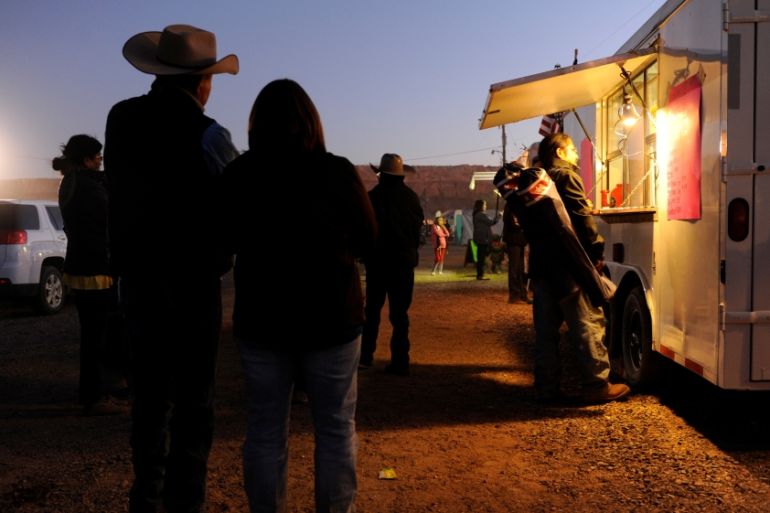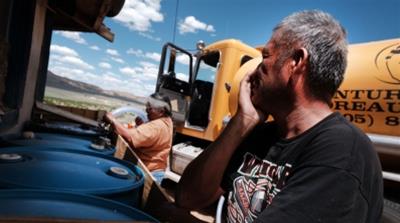Navajo Nation: Fears of hunger as COVID-19 lockdown to intensify
Navajo authorities set to ramp up coronavirus restrictions as US aid trickles into tribal lands facing food insecurity.

The continuing coronavirus pandemic in the United States is putting pressure on the food infrastructure of the Navajo Nation as authorities continue issuing restrictions in hopes of slowing the virus’s spread.
Navajo authorities have attempted to get ahead of the virus, instituting a curfew from 8:00pm to 5:00am, which local police started enforcing with fines on April 4.
Keep reading
list of 3 itemsWorld opinion shifts in favour of masks as virus fight deepens
Nigeria COVID-19 survivor: ‘An experience I don’t wish on anyone’
But the number of cases has continued to climb. As of Monday, there were at least 384 confirmed cases and 15 deaths from COVID-19, the disease the virus causes, as of April 6.
“One death is one way too many,” Navajo Nation President Jonathan Nez was quoted as saying by local media.
Navajo authorities on Monday said they would implement a 57-hour total lockdown from 8pm on April 10 until 5am on April 13, unless in case of an emergency. This could place huge burdens on food and water delivery on tribal lands.
“Our tribe is trying to take all safety measures to protect our communities and it has come to this weekend one now,” said Denisa Livingston, an organiser with the Dine Community Advocacy Alliance (DCAA), a group that mobilises “community members to combat obesity, diabetes, and other chronic health issues” by increasing awareness of traditional food and lifestyle choices.
The situation the coronavirus pandemic presents is difficult, but familiar to Indigenous communities in the US, Livingston told Al Jazeera.
“We have already been experiencing these issues pre-COVID[-19] … Now the world is finally experiencing what has been happening in Indian country.”
‘Food apartheid’
The Navajo Nation is roughly the same size as West Virginia, 71,000 square kilometres (27,413 square miles).
It is a semi-autonomous territory spanning three US states – Arizona, New Mexico, and Utah. It essentially serves as a reservation for more than 350,000 Navajo (or Dine, in their language) people who live there.
There are 13 full-service supermarkets on the Navajo Nation, and one closed on April 1 after an employee tested positive for the coronavirus.
Though some have referred to the situation of food distribution in the Navajo Nation a “food desert”, Livingston used the phrase “food apartheid”.

Now, with the curfew, “hunger is becoming an issue”, Livingston said.
The lack of easy access to food – especially healthy options – has been a problem for Navajo people for years.
A 2006-07 study by Johns Hopkins University found that more than 76 percent of households faced food insecurity on the Navajo Nation.
According to the study, many Navajo also face obesity, diabetes and depression “and poor general health” – conditions believed to make people more susceptible to complications from COVID-19.
While difficulties around food access are rising during the coronavirus crisis, “at the same time resilience has been escalating”, Livingston said.
Without the ability to travel long distances, people on Navajo Nation can and should employ ancestral ways of life with greater frequency, according to the DCAA organiser.
These practices include cultivation of food at the home, making physical checks on elders in the community as opposed to using mobile phones and other forms of community support, including food deliveries to at-risk homes.
That community support does venture into the digital realm. There have been numerous fundraisers, including a GoFundMe for Navajo and Hopi families that has raised nearly $400,000 since March 15.
Much of the funds raised has been used to distribute food to hundreds of people, according to posts by organiser Ethel Branch.
Government response
As grassroots fundraising efforts approach half a million dollars, some question the federal government’s approach to delivering aid to the hard-hit Navajo Nation.
The US government has allotted $8bn to Indigenous communities in the country to combat the coronavirus pandemic through the $2.2 trillion CARES Act.
These funds will be distributed through the Indian Health Service (IHS), an agency in the US Department of Health and Human Services (HHS), which provides healthcare to approximately 2.6 million Indigenous people in the contiguous 48 states and Alaska Natives who belong to 574 federally recognised tribes in 37 states.
“The funding secured by President Trump to combat the coronavirus is delivering significant investments in the Indian Health Service and tribal communities’ ability to respond to the COVID-19 public health emergency,” HHS Secretary Alex Azar said in a statement emailed to Al Jazeera.
“With these funds from Congress and HHS efforts to ensure IHS facilities have access to the latest testing, we are working to equip tribal communities with what they need to respond to the coronavirus pandemic”, Azar said.
The CARES Act stipulates that Secretary of the Treasury Steven Mnuchin must distribute the full $8bn by April 27, though it does not provide guidelines for its distribution.
Lawmakers have expressed concern about the government’s response. While the Federal Emergency Management Agency (FEMA) has delivered needed supplies and the Arizona National Guard has helped Navajo Nation efforts, more is needed, they said.
“Since we first learned of the serious threat the coronavirus poses to our communities, I have been concerned with the lack of attention the Navajo Nation has received from state and federal agencies responsible for COVID-19 preparedness and response efforts,” Arizona Democratic Representative Tom O’Halleran, a member of Congressional Native American Caucus whose district includes a large portion of the Navajo Nation, said in an April 3 bipartisan letter to Mnuchin and Interior Secretary David Bernhardt.
As cases have jumped in the Navajo Nation, legislators have “seen delay and confusion from federal agencies”, Halleran continued.
“Tribal governments are best equipped to respond to the needs of their members and the Treasury Department must move swiftly to make sure tribal governments have the funds they need to do so.”
Livingston also noted the delayed response, citing the sizable bureaucracies of both the IHS and local tribes as hurdles.
Now that the Navajo Nation is the epicentre of the coronavirus pandemic on tribal lands, Livingston hopes her people can learn through the difficulties.
“Returning back to our ways has been a critical point now in learning from a crisis like this,” Livingston concluded.